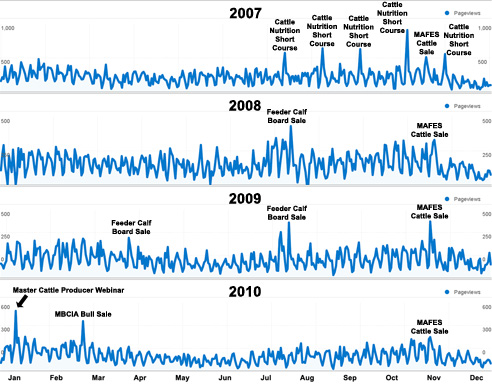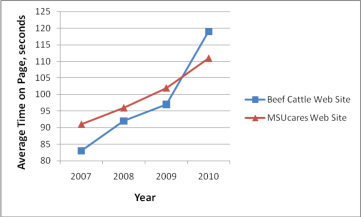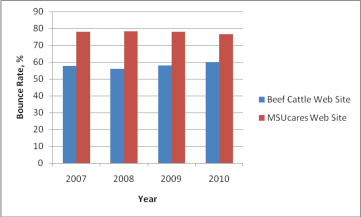 |
October 2011
|
October 2011 // Volume 49 // Number 5 // Tools of the Trade // v49-5tt9
Website Usage Information for Evaluating Beef Cattle Extension Programming
Abstract
A beef cattle Extension website was evaluated over a 4-year period using Web analytics software to determine usage trends, assess website quality and areas where improvements were needed, and identify beef cattle Extension programming interest among clientele. Website pageviews peaked at times when the website was an integral component of an Extension program, and seasonal trends in viewing were observed. Indicators of website quality were favorable relative to the entire Extension website for the state. The information obtained from this analysis was utilized to improve the website and beef cattle Extension programming efforts.
Introduction
A beef cattle website <http://msucares.com/livestock/beef> (hereafter the website) developed and hosted by the Mississippi State University Extension Service was evaluated over a 4-year period in order to 1) examine usage trends, 2) assess website quality and areas where improvements were needed, and 3) identify beef cattle Extension programming interest among clientele. Google™ Analytics, a Web analytics program that allows for detailed tracking of website traffic (Patton & Kaminski, 2010), was used to track the website's impact for the years of 2007 through 2010. Website usage trends were compared to those for the entire Mississippi State University Extension Service website, <http://msucares.com> (hereafter MSUcares).
Website Usage
The website tallied 236,130 pageviews from 2007 through 2010. For this period, it accounted for just over 1% of the pageviews on MSUcares. Daily pageviews for the website appear in Figure 1. Periods with sharp increases in website pageviews corresponded with major beef cattle Extension programming events. Many of these peaks were associated with cattle sales where the catalog, videos of individual animal lots for sale, and live Internet streaming of the sales were hosted on the website. Other major temporary increases in website pageviews were associated with a webinar conducted using the website and a short course where educational materials for the short course were posted on the website.
Figure 1.
Daily Website Pageviews from
2007 Through 2010

For example, a beef cattle nutrition short course was conducted on five dates in 2007 over interactive video. The short course was promoted in Mississippi, Alabama, and Louisiana. Slide presentations were posted on the website on the day of each presentation. Participants were referred to the website to access these slide presentations as reference materials. At the time of the short course, many participants indicated that they downloaded and printed slides from the website. The website usage data confirm this.
Seasonal website use has been documented for other Extension programming areas (Neal, 2010). A review of the website pageviews indicated that Internet traffic to the site tended to slow in late spring and early summer, and again in December. In late spring and early summer, beef cattle producers often spend extended hours working on the farm with the long day lengths and demands of forage production that time of year. This leaves fewer hours for Internet browsing. The lower number of pageviews in December may be attributed to the holidays in that month. Pageviews tended to the increase in January and again in late July.
Quality of Website Visits
For both the website and MSUcares, the average time users spent on pages within these sites increased each year from 2007 through 2010 (Figure 2). However, through 2009 the website lagged MSUcares in average time on page. Then in 2010 the website surpassed MSUcares for average time on page. This was largely due to website users spending more time in 2010 viewing the commodity feed source directory, feeder calf board sale information, online trainings such as the Mississippi Beef Quality Assurance Program and Mississippi Master Cattle Producer Program, and beef cattle Extension publications. Extension specialists updated and increased the amount of information from 2008 through 2010 on these pages within the website. The longer pageviews were likely the result of these efforts.
Figure 2.
Comparison of Beef Cattle
Website and MSUcares Website for Average Time on Page over Time

Bounce rate refers to the percentage of single-page visits or visits in which the person left a site from the entrance (landing) page. Visitors who enter the site and "bounce" do not continue to view other pages within the site. Bounce rate is an indicator of visit quality, with a high rate indicating that entrance pages are not relevant to visitors. Figure 3 shows the respective bounce rates from 2007 through 2010 for the website and MSUcares. The website consistently outperformed MSUcares for bounce rate, providing another indication of website quality in relation to other local Extension websites.
Figure 3.
Comparison of Beef Cattle
Website and MSUcares Website for Bounce Rate

Identifying Program Interest
Each page within the website represented either a specific Extension program (e.g., Mississippi Farm to Feedlot Program) or information category (e.g., calendar of upcoming beef cattle Extension events). Website usage data were available for each page within the website. This allowed comparisons of pageviews, average time on page, and bounce rate among the pages. Pages were then ranked for these performance indicators within year. Trends over the 4-year period for each page were also identified.
Conclusions
Prior to the use of Google™ Analytics in February 2011 to assess website usage from 2007 through 2010, face-to-face feedback from a limited number of clientele and Extension agents was relied upon to assess the education value of website content. While useful, this feedback did not provide an accurate assessment of overall website usage or the quality of these visits. It also did not provide a comprehensive evaluation of individual Web pages within the website. The Web analytics program provided objective information that was then used to make improvements to the website and beef cattle Extension programming efforts.
References
Neal, J. W. (2010). The first 4 years of a warmwater recreational pond management web site in Arkansas. Journal of Extension [On-line], 48(3) Article 3FEA4. Available at http://www.joe.org/joe/2010june/a4.php
Patton, A. J., & Kaminski, J. E. (2010). Tracking the impact of your Web-based content. Journal of Extension [On-line], 48(4) Article 4TOT1. Available at http://www.joe.org/joe/2010august/tt1.php




